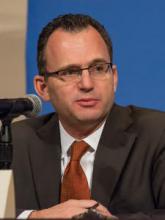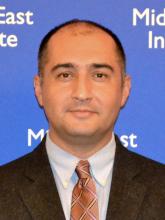In this week's Monday Briefing, MEI experts Paul Salem, Robert S. Ford, Charles Lister, Alex Vatanka, and David Mack provide analysis on recent and upcoming events including Obama’s upcoming final speech to the UN General Assembly, the Syrian collapsed ceasefire, the buildup to an eventual Mosul offensive, Rouhani's trip to Latin America, and Libya's oil exports.
Obama’s Last UNGA Speech and his MidEast Legacy
Paul Salem, Vice President for Policy and Research
In his first UN speech in 2009, President Obama emphasized four pillars of his foreign policy: stop the spread of nuclear weapons; reach an Israeli-Palestinian peace deal and combat terrorism; address climate change; and put the global economy on a more solid footing. On Tuesday, he can announce that he has made progress on 1, 3 and 4.
In his 2013 speech he announced that the United States had four core interests in the Middle East: maintaining the free flow of energy; stopping the spread of weapons of mass destruction; confronting external aggression against allies; and combatting terror. Energy flows and prices are in good shape, and the J.C.P.O.A. has temporarily blocked Iran’s path to a nuclear weapon and avoided further nuclear proliferation in the Middle East. U.S. national security relations with its allies in the region remain robust, despite cool relations between Obama and regional leaders.
But under Obama, terrorism has gone from bad to worse. Events and policy choices in Iraq and Syria enabled the rise of the Islamic State and that, coupled with refugee flows from Syria, have already struck Europe and threatened the United States. At the political level, the Obama administration has ended up with poor relations with all of America’s allies in the Middle East, and it has lost deterrence with its adversaries, mainly Iran and a resurgent Russia—let alone a defiant Assad.
Obama will leave office with a job half-done in the Middle East with relative success on energy and weapons of mass destruction. But the next president will have to figure out a way to rebuild stability in the Middle East, dramatically weaken terrorist groups, and repair relations with partners and deterrence with adversaries.
Syria Cease-Fire Deal Collapses
Robert S. Ford, Senior Fellow
The Syrian government declared today the end of the cessation of hostilities. A series of violations toward the end of last week, many of them committed by the regime itself, have undone the U.S.-Russian brokered cease-fire. Regime airstrikes over the weekend hit Aleppo, Idlib, and suburban Damascus, including areas where extremists are not present. According to the U.N., the Syrian government was preventing aid convoys from reaching opposition-held besieged communities even though the Syrian government asserted September 17 that it was doing all it was required to do. The Syrian armed opposition on September 18 warned they’ll abandon the cease-fire entirely if government forces keep attacking besieged communities or compelling evacuation of residents. The first test of this threat could come today when several hundred Jabhat Fateh al-Sham fighters are to quit the besieged district of Waer in Homs city.
Adding further strain to the cease-fire, the United States admitted on September 17 that its coalition had mistakenly struck Syrian army positions in the eastern city of Deir Ezzor, provoking new rhetorical broadsides with Russia. The Russians are also demanding that Washington force moderate rebels to physically separate themselves from the al-Qaeda-linked Fateh al-Sham fighters. The Americans lack the leverage, and Fateh al-Sham’s leader said in an interview aired September 17 that merger talks are underway with other major rebel groups.
The final collapse of the cessation deal, whether due to aid blockades or more fighting, will likely propel that merger among Syrian rebels and impede the announced U.S.-Russian goal of coordinated airstrikes against extremists in Syria. Even if the Russians and Americans ever do coordinate airstrikes, the erroneous Deir Ezzor attack shows the limits of militarily actionable intelligence on the complicated Syrian battlefield.
U.S.-Coalition Continues Prep for Mosul Offensive
Charles Lister, Senior Fellow
After more than two years, the anti-ISIS coalition is finally reaching the doorsteps of Mosul. With the issue of displaced people already crippling northern Iraq and the K.R.G., the fight for Mosul could end up forcing as much as a million more from their homes.
Although substantial pre-operation challenges remain unresolved, it appears increasingly likely that we’ll see Mosul’s outer limits under attack within the next eight weeks. Several hundred U.S. troops just arrived in the operation’s crucial staging area: Qayyara airbase, south of the city. Given its importance, ISIS will almost certainly seek to launch pre-emptive attacks in Qayyara’s vicinity in the coming weeks.
For now, Kurdish peshmerga are the closest force to Mosul—positioned 10km away on Mount Bashiqa, with some forward-deployed units as little as 1km from ISIS positions. According to Kurdish sources, ISIS remains deeply embedded in Mosul, with tunnels dug 20ft below ground, equipped with bathrooms and substantial food supplies. Given ISIS’ previous record, large numbers of car and truck bombs are undoubtedly ready for a ‘shock and awe’ defense.
Despite being further away—65km, in Qayyara—the Iraqi army and elite members of the Counter-Terrorism Service and Golden Division are the critical components for U.S. strategy. The role of the divisive and often Iranian-backed militias remains worryingly unclear. So too does the role of Turkey and its tribal proxy, al-Hashd al-Watani, which are deployed only 15km from Mosul.
Any battle for Mosul will be long and highly destructive, but ultimately it’ll be the days after that matter the most. No operation should be launched until stabilization issues are fully resolved.
Rouhani’s Underwhelming Latin America Pop-In
Alex Vatanka, Senior Fellow
Last week, Iran’s President Hassan Rouhani visited Venezuela to attend the summit of the Non-Aligned Movement and hand over the rotating presidency of the bloc to Venezuela. From there he travelled to Cuba before flying to New York to attend the U.N. General Assembly. Rouhani’s trip to Latin America late in his first term is consistent with his promises of strengthening Iran’s standing on the international stage. Still, his hardline critics that have constantly accused him of pursuing an unbalanced foreign policy that puts disproportionate emphasis on relations with the West say he has through neglect undermined Iran’s influence in the region.
Rouhani’s predecessor, Mahmoud Ahmadinejad, invested huge political capital in Latin America and fashioned strong personal ties with leaders such as Hugo Chavez of Venezuela and Evo Morales of Bolivia. Iranian investments increased notably there, but this was only possible due to historic high oil prices that the Ahmadinejad presidency enjoyed. Rouhani from the beginning made it clear he would not focus on symbolic relations to lessen the perception of Iranian isolation in the world, but prioritize ties with countries that are important to Iran’s economic interests. Europe took precedence for the Rouhani team and it is unlikely that Latin America will return anytime soon as darlings of Tehran, as was the case under Ahmadinejad.
For Rouhani, the main priority remains tangible economic benefits, including attracting foreign investment and transfer of technological know-how to Iran’s important sectors such as the energy industry. It has also been noticeable that the Rouhani administration did little to publicize Iran's presidency of N.A.M., again underscoring its unwillingness to bank on make-believe policy ventures.
Libya’s Oil Exports Complicated by Hifter
David Mack, MEI Scholar
Seizure of major Libyan oil terminals by units of the Libyan National Army loyal to General Khalifa Hifter puts added strain on the Tripoli-based Government of National Accord (G.N.A.). The Libyan National Oil Company (L.N.O.C.) falls under the authority of the G.N.A., and the U.N. Security Council resolution 2146 prohibits the export of Libyan oil outside of this channel.
Libyan militias have struggled over control of oil fields, pipelines and terminals. Libyan crude oil exports have declined to a fraction of the country’s exports prior to the overthrow of the Qaddafi government. The Libyan economy is overwhelmingly dependent on oil revenues, and no central government will be viable for long without succeeding in raising exports back toward pre-revolution levels.
Hifter is supported by the remnants of an elected parliament in Tobruk and the mostly inoperative government in Baida, both in eastern Libya. He has been unable to gain full control over the major eastern city of Benghazi, and his claim to leadership of the army and other Libyan military forces is strongly opposed by most factions in western Libya. The capture of the oil terminals gives him a bargaining chip with the G.N.A. He was already allowing a small export stream from the far eastern terminal of Hariga near Tobruk with revenues going to the national oil company. L.N.O.C. is trying to work out modalities with Hifter for resumption of exports from the four terminals he seized along the central Libyan oil crescent—Zwitina, Brega, Ras Lanuf and Sidra. If this succeeds, it will improve his chances of gaining a measure of national legitimacy, although likely less than he seeks.
The Middle East Institute (MEI) is an independent, non-partisan, non-for-profit, educational organization. It does not engage in advocacy and its scholars’ opinions are their own. MEI welcomes financial donations, but retains sole editorial control over its work and its publications reflect only the authors’ views. For a listing of MEI donors, please click here.


















